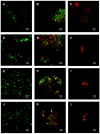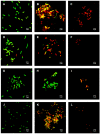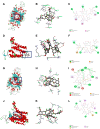Antibacterial and Sporicidal Activity Evaluation of Theaflavin-3,3'-digallate
- PMID: 35216265
- PMCID: PMC8877948
- DOI: 10.3390/ijms23042153
Antibacterial and Sporicidal Activity Evaluation of Theaflavin-3,3'-digallate
Abstract
Theaflavin-3,3'-digallate (TFDG), a polyphenol derived from the leaves of Camellia sinensis, is known to have many health benefits. In this study, the antibacterial effect of TFDG against nine bacteria and the sporicidal activities on spore-forming Bacillus spp. have been investigated. Microplate assay, colony-forming unit, BacTiter-GloTM, and Live/Dead Assays showed that 250 µg/mL TFDG was able to inhibit bacterial growth up to 99.97%, while 625 µg/mL TFDG was able to inhibit up to 99.92% of the spores from germinating after a one-hour treatment. Binding analysis revealed the favorable binding affinity of two germination-associated proteins, GPR and Lgt (GerF), to TFDG, ranging from -7.6 to -10.3 kcal/mol. Semi-quantitative RT-PCR showed that TFDG treatment lowered the expression of gpr, ranging from 0.20 to 0.39 compared to the control in both Bacillus spp. The results suggest that TFDG not only inhibits the growth of vegetative cells but also prevents the germination of bacterial spores. This report indicates that TFDG is a promising broad-spectrum antibacterial and anti-spore agent against Gram-positive, Gram-negative, acid-fast bacteria, and endospores. The potential anti-germination mechanism has also been elucidated.
Keywords: anti-germination; antibacterial; binding analysis; black tea polyphenol; natural product; sporicidal; theaflavin.
Conflict of interest statement
The authors declare no conflict of interest.
Figures







Similar articles
-
Theaflavin-3,3´-digallate increases the antibacterial activity of β-lactam antibiotics by inhibiting metallo-β-lactamase activity.J Cell Mol Med. 2019 Oct;23(10):6955-6964. doi: 10.1111/jcmm.14580. Epub 2019 Aug 8. J Cell Mol Med. 2019. PMID: 31392792 Free PMC article.
-
Difference in the antibacterial action of epigallocatechin gallate and theaflavin 3,3'-di-O-gallate on Bacillus coagulans.J Appl Microbiol. 2020 Sep;129(3):601-611. doi: 10.1111/jam.14662. Epub 2020 Apr 29. J Appl Microbiol. 2020. PMID: 32281733
-
Quantitative analysis of the effect of specific tea compounds on germination and outgrowth of Bacillus subtilis spores at single cell resolution.Food Microbiol. 2015 Feb;45(Pt A):63-70. doi: 10.1016/j.fm.2014.03.006. Epub 2014 Mar 16. Food Microbiol. 2015. PMID: 25481063
-
Colorectal cancer and inflammatory bowel diseases: effects of diet and antioxidants.J Biol Regul Homeost Agents. 2017 Jul-Sep;31(3):791-795. J Biol Regul Homeost Agents. 2017. PMID: 28726358 Review.
-
Chlorhexidine: antibacterial action and bacterial resistance.Infection. 1986 Sep-Oct;14(5):212-5. doi: 10.1007/BF01644264. Infection. 1986. PMID: 3539812 Review.
Cited by
-
NcRNA Regulated Pyroptosis in Liver Diseases and Traditional Chinese Medicine Intervention: A Narrative Review.J Inflamm Res. 2024 Apr 3;17:2073-2088. doi: 10.2147/JIR.S448723. eCollection 2024. J Inflamm Res. 2024. PMID: 38585470 Free PMC article. Review.
-
Synthesis of Antibacterial Copper Oxide Nanoparticles by Pulsed Laser Ablation in Liquids: Potential Application against Foodborne Pathogens.Nanomaterials (Basel). 2023 Jul 29;13(15):2206. doi: 10.3390/nano13152206. Nanomaterials (Basel). 2023. PMID: 37570524 Free PMC article.
-
Frontiers in Antimicrobial Biomaterials.Int J Mol Sci. 2022 Aug 19;23(16):9377. doi: 10.3390/ijms23169377. Int J Mol Sci. 2022. PMID: 36012640 Free PMC article.
-
Beneficial Effects of Theaflavins on Metabolic Syndrome: From Molecular Evidence to Gut Microbiome.Int J Mol Sci. 2022 Jul 8;23(14):7595. doi: 10.3390/ijms23147595. Int J Mol Sci. 2022. PMID: 35886943 Free PMC article. Review.
-
A Comprehensive Review of Theaflavins: Physiological Activities, Synthesis Techniques, and Future Challenges.Food Sci Nutr. 2025 Aug 6;13(8):e70762. doi: 10.1002/fsn3.70762. eCollection 2025 Aug. Food Sci Nutr. 2025. PMID: 40772015 Free PMC article. Review.
References
-
- CDC . Antibiotic Resistance Threats in the United States. US Department of Health and Human Services, CDC; Atlanta, GA, USA: 2019. - DOI
-
- Hilal Y., Engelhardt U. Characterisation of white tea—Comparison to green and black tea. J. Verbrauch. Lebensm. 2007;2:414–421. doi: 10.1007/s00003-007-0250-3. - DOI
MeSH terms
Substances
LinkOut - more resources
Full Text Sources
Medical
Miscellaneous

